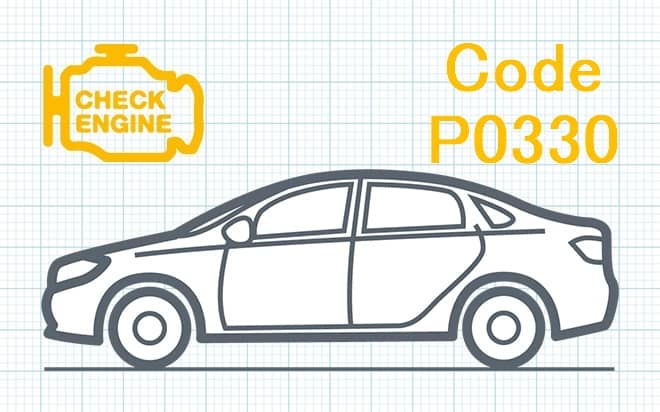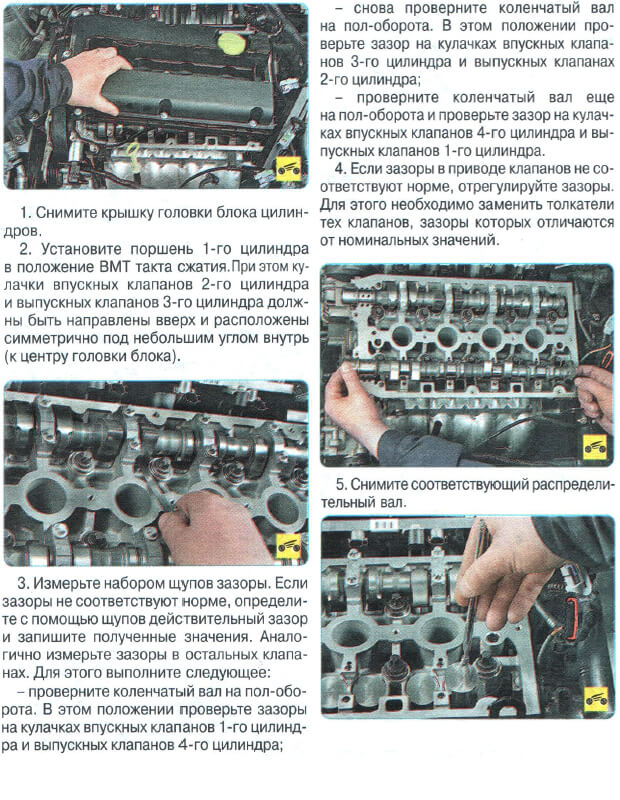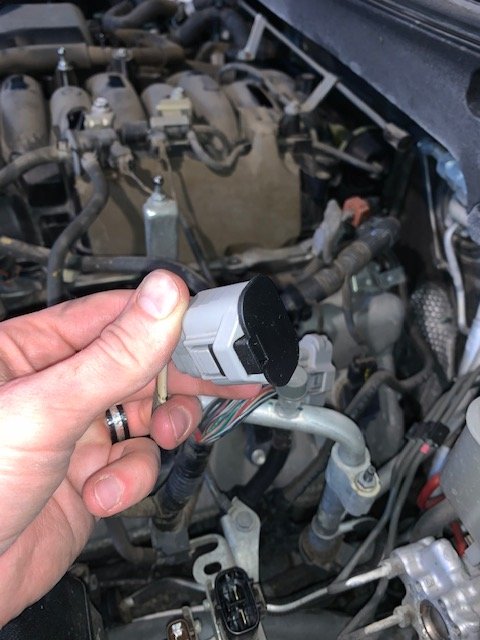
P0330 Knock Sensor Circuit Malfunction (Sensor 2 Bank 2)
Content
P0330 – OBD-II Trouble Code Technical Description
Trouble code P0330 is a generic trouble code that indicates a malfunction in the knock sensor 2 (bank 2) circuit.
What does the fault code mean P0330?
Trouble code P0330 indicates that the vehicle's engine control module (ECM) has detected a fault in the second knock sensor (bank 2) circuit.
When this DTC occurs, the Check Engine light will turn on on your vehicle's dashboard. It will remain active until the problem is resolved.

Possible reasons
Some possible reasons for the P0330 trouble code:
- Faulty knock sensor: The most common case. The knock sensor may be worn or damaged, resulting in an incorrect signal or no signal at all.
- Wiring or Connector Issues: The wiring connecting the knock sensor to the ECM (Engine Control Module) may be damaged, broken, or have poor contact, resulting in the P0330 code.
- Improper installation of the knock sensor: If the sensor has recently been replaced or moved, improper installation may result in incorrect operation and therefore a P0330 code.
- ECM Problems: A faulty ECM, the engine control module, can also cause P0330 because the ECM may not correctly interpret signals from the knock sensor.
- Engine Mechanical Problems: Certain mechanical problems, such as detonation, ignition or flywheel problems, can cause the P0330 code.
To accurately determine the cause of the P0330 code, it is recommended to carry out diagnostics using a diagnostic scanner and, if necessary, contact a professional mechanic or auto repair shop.
What are the symptoms of a fault code? P0330?
Symptoms when trouble code P0330 is present may include the following:
- Rough Idle: The engine may idle rough due to an incorrect signal from the knock sensor.
- Loss of Power: A faulty knock sensor can cause the engine to lose power, especially at low rpm or when accelerating.
- Unstable Acceleration: Improper operation of the knock sensor can cause instability during acceleration, which may manifest itself as jerking or hesitation.
- Increased fuel consumption: Due to improper operation of the knock sensor, incorrect fuel delivery may occur, which can lead to increased fuel consumption.
- Activating the Check Engine Light: When the P0330 trouble code appears, the Check Engine Light will be activated on the vehicle's dashboard.
- Unusual Engine Sounds: In some cases, a malfunctioning knock sensor can result in unusual sounds coming from the engine, such as knocking or knocking noises.
If you notice any of these symptoms and your Check Engine Light is activated, it is recommended that you take it to an auto mechanic to diagnose and repair the problem.
How to diagnose a fault code P0330?
To diagnose DTC P0330, the following steps are recommended:
- Connect the diagnostic scanner: Use the OBD-II diagnostic scanner to read the P0330 trouble code and any other trouble codes that may be stored in the engine control module (ECM).
- Check the condition of the knock sensor: Check the knock sensor for damage, wear, or corrosion. Make sure it is installed correctly and connected to its connector.
- Check Wiring and Connections: Inspect the wiring and connectors connecting the knock sensor to the ECM. Make sure the wiring is not damaged and the connectors are securely connected and free of corrosion.
- Check sensor operation: Use a multimeter to check the operation of the knock sensor. Check its resistance or output voltage according to your vehicle specifications. If the sensor does not work correctly, replace it.
- Check the ignition system: Check the condition of the ignition system, as well as the fuel system components. Problems with these systems can also result in a P0330 code.
- Check Engine Control Module (ECM): In rare cases, the problem may be due to a faulty ECM. If the problem persists after checking all other components, the ECM may need to be diagnosed using specialized equipment.
- Additional tests: Depending on your specific conditions and the nature of the problem, perform additional tests to rule out other possible causes.
After completing these steps and determining the cause of the P0330 code, make the necessary repairs or replacement parts.
Diagnostic errors
When diagnosing DTC P0330, the following errors may occur:
- Faulty wiring or connectors: The error may be caused by problems with the wiring or connectors connecting the knock sensor to the ECM. Incorrect connections, corrosion, or broken wiring can cause the P0330 code to appear.
- Faulty Knock Sensor: The knock sensor itself may be faulty, causing a P0330 code. This may occur due to wear or damage to the sensor.
- ECM Problems: In some cases, the problem may be related to the ECM, which may not correctly interpret signals from the knock sensor.
- Engine Mechanical Problems: Certain mechanical problems, such as a bad flywheel or detonation due to improper valve operation, can cause the P0330 code to appear.
- Improper Knock Sensor Installation: If the knock sensor has recently been replaced or moved, improper installation may cause the P0330 code.
When diagnosing a P0330 code, it is important to thoroughly check all of the above components to pinpoint the cause of the code and make the appropriate repairs.
How serious is the fault code? P0330?
Trouble code P0330 should be taken seriously as it indicates problems with the knock sensor, which is an important component of the engine management system. A few reasons why this code should be taken seriously:
- Loss of Power: Improper operation of the knock sensor can cause the engine to lose power, affecting engine performance and efficiency.
- Risk of Engine Damage: The knock sensor helps prevent knocking, which is dangerous to the engine and can cause serious damage if the problem is not corrected.
- Engine Roughness: Improper operation of the knock sensor can cause unstable idle speed, which can result in poor engine performance.
- Increased Fuel Consumption: A malfunctioning knock sensor may cause the engine to use more fuel, resulting in increased fuel consumption and increased operating costs.
- Risk of Damage to Other Components: Incorrect operation of the knock sensor can cause engine overheating or other problems, which can damage other vehicle components.
Overall, the P0330 trouble code requires careful attention to avoid serious engine damage and keep your vehicle running safely and efficiently. If you encounter this error code, it is recommended that you contact a qualified mechanic or auto repair shop to diagnose and repair the problem.
What repair will help eliminate the code? P0330?
Troubleshooting DTC P0330 may require the following:
- Replacing the knock sensor: If the knock sensor is faulty or broken, you need to replace it with a new one. Make sure the new sensor meets the manufacturer's specifications.
- Wiring and Connectors Inspection and Repair: Check the wiring, connections, and connectors associated with the knock sensor. Make sure the wiring is intact, the connectors are securely connected and free of corrosion. Repair or replace damaged components as necessary.
- Ignition and fuel system check: Check the condition of the ignition and fuel system, as problems in these systems can also cause the P0330 code. Replace worn or damaged components.
- Checking and Possibly Replacing the Engine Control Module (ECM): In rare cases, the problem may be due to a faulty ECM. If the problem persists after checking all other components, the ECM may need to be diagnosed and replaced.
- Additional tests: Run additional tests and diagnostics to ensure the problem is completely resolved.
Once the necessary repairs have been completed, it is recommended that you reconnect the scan tool and test for DTC P0330. If the code does not appear, the problem has been successfully resolved. If the code is still present, it is recommended that you perform additional diagnostics or contact a qualified mechanic for further action.
P0330 – Brand-specific information
Trouble code P0330 relates to the engine knock system and can be applied to different makes of vehicles. Here are the decodings of this code for some specific brands:
- Toyota: On Toyota vehicles, the P0330 code may indicate problems with the knock sensor (Knock Sensor Bank 2 Circuit Malfunction).
- Honda: For Honda vehicles, this code may indicate a faulty knock sensor circuit (Knock Sensor 2 Circuit Malfunction Bank 2).
- Ford: On Ford vehicles, the P0330 code may also indicate a malfunction in the knock sensor circuit (Knock Sensor 2 Circuit Malfunction Bank 2).
- Chevrolet: For Chevrolet, the P0330 code may be due to an incorrect signal from the knock sensor (Knock Sensor 2 Circuit Malfunction Bank 2).
- BMW: For BMW, this code may indicate problems with the knock sensor circuit (Knock Sensor 2 Circuit Malfunction Bank 2).
- Mercedes-Benz: On Mercedes-Benz vehicles, the P0330 code may indicate a malfunction in the second circuit of the knock sensor (Knock Sensor 2 Circuit Malfunction Bank 2).
These are just a few examples, and the specific meaning of the P0330 code may vary depending on the model and year of the vehicle. It is recommended that you consult the repair or service manual for your specific make and model of vehicle for accurate information.

